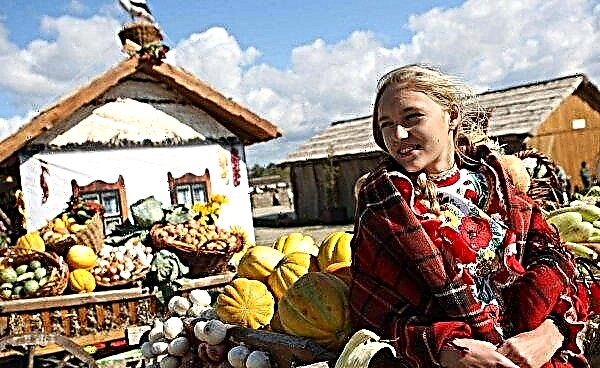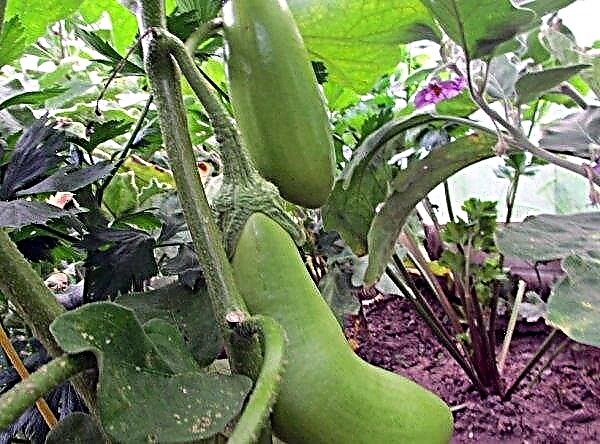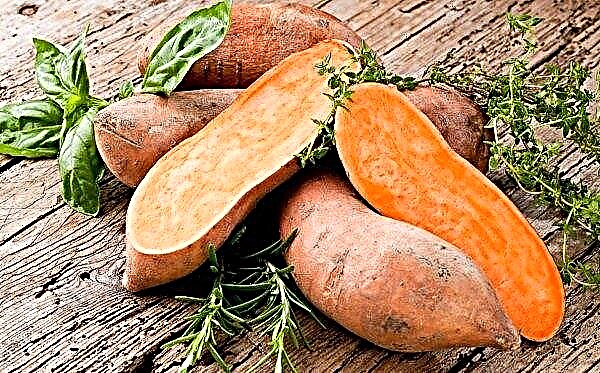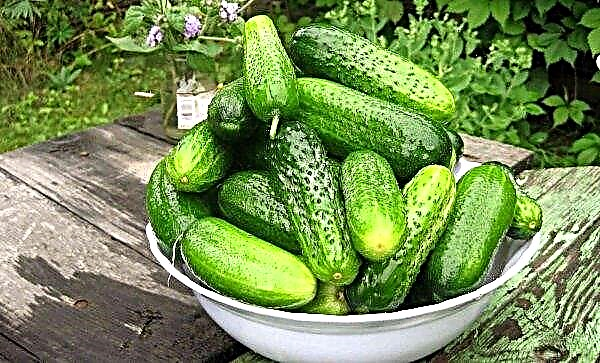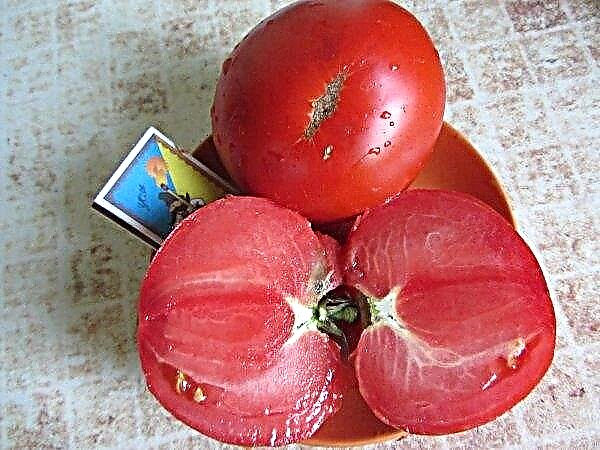Highsex chickens are known primarily for their productivity and quality of poultry products, which is why the breed is considered one of the most common among large poultry farms, as well as small private farms. But, the breeding of this bird is a rather complicated and specific process, which for many becomes a real headache. We will examine in detail the main subtleties of the breeding of Highsex chickens, as well as tell the main secrets of this breed.
Highsex Cross Description
Hysex is a highly productive hybrid of poultry that is obtained by direct cross-breeding of donor animals under strict rules. This means that breeding within the breed is not observed, therefore new individuals are obtained exclusively after crossing the original breeds.
The basis for the production of poultry was the breeds known in Europe: white leggorn, rhode island and New Hampshire chicken. The history of all highsexes began in 1968, in the Netherlands. Within the walls of the local agricultural enterprise Euribrid, the best ornithologists and breeders spent two years crossing all kinds of breeds between the most popular breeds of poultry.
The history of all highsexes began in 1968, in the Netherlands. Within the walls of the local agricultural enterprise Euribrid, the best ornithologists and breeders spent two years crossing all kinds of breeds between the most popular breeds of poultry.
In 1970, they launched a fast-growing and highly productive cross, characterized by improved product quality and unpretentiousness in maintenance.
From that moment, the active spread of High-tech chickens throughout the world began. Farmers from the USA and Canada took the most active part in the novelty, but by 1985 the breed became widespread in North and South America, Europe and Asia. Today, the breed is a traditional bird both in industrial breeding and in conditions of private rearing.
Did you know? One of the first states that actively introduced this bird into industrial poultry farming was the Soviet Union. As early as 1974, the first hybrids were obtained on the territory of the Ukrainian SSR, which in just a few years helped massively distribute poultry in Siberia, the Urals and the central part of the country.
The breed involves the division of the bird into two separate crosses (hybrids):
- White - Differ in an ideal white shade of plumage. Get a hybrid based on white leggorn and New Hampshire. The main distinguishing feature of the cross is a graceful, slightly elongated body and perfect uniform eggs.
- Brown - can be determined due to the rich brown-red plumage. The hybrid differs from its predecessor in its massive, rounded, but proportional body and large egg, weighing about 70 g. They are obtained by crossing leggorn, rhode islands and New Hampshire layers.
Appearance
The main distinguishing feature of all highsexes is the graceful and proportional body. Despite the fact that at first glance the representatives of the breed look awkward, in fact they are active, energetic and quite confident when moving birds.
Highcase White Chicken Features:
| Part of the body | Description |
| Head | Small |
| Crest | High, leaf-shaped, 4-5 toothed, saturated red tones. Erect in roosters, in chickens hanging to one side |
| Beak | Small, thin, slightly bent down |
| Neck | Proportional, medium length or slightly elongated |
| Chest | Thin but round |
| Stomach | Proportional, slightly rounded |
| Wings | Medium in size, tightly pressed to the body |
| Tail | Long and wide, set at 40 ° |
| Paws | Short and thin |
| Plumage color | White or snow-white; golden feathers may occur on individual feathers |

Highcase Brown Chicken Features:
| Part of the body | Description |
| Head | Small |
| Crest | Leaf-shaped, tall, with 4-5 teeth, erect. Mostly bright red |
| Beak | Small, thin, slightly bent down |
| Neck | Medium length proportional |
| Chest | Small, rounded |
| Stomach | Proportional slightly rounded |
| Wings | Small, strong, fit snugly to the body |
| Tail | Medium length, covered with short plaits, often set at an angle of 40-45 ° |
| Paws | Medium length, dense and powerful |
| Plumage color | Brown or golden brown, individual feathers have a small white border |

Productive qualities
The Highsex breed is known not only for its productivity, but also for its precocity. But, despite this, most farmers only have a rough idea when these hens begin to rush, and what products can be obtained by growing them.
Did you know? The largest chicken egg in the world was laid in 2010 in the town of Eastwood (UK). It had a diameter of 23 cm and a weight of 163 g.
While for small private farms this issue is not acute, for large poultry farms these features can play a decisive role in the profitability of the entire production.
High-Hex White Chickens Productivity:
| Characteristic | Description |
| The average weight of chicken and rooster | Chicken - 1.7 kg, rooster - 1.7—2 kg |
| Direction | Egg |
| Puberty | It occurs at the age of 4-5 months |
| Average egg production per year | 320 eggs |
| Average egg weight | About 60 g |
| Egg color | White |
| Instinct of incubation | Reduced or completely lost |
| Taste indicators of meat | The meat is fragrant, juicy, with a delicate texture |
High Chicken Brown Chickens Productivity:
| Characteristic | Description |
| The average weight of chicken and rooster | Chicken - 2 kg, rooster - 2.5-3 kg |
| Direction | Meat and egg |
| Puberty | It occurs at the age of 4-5 months |
| Average egg production per year | 300 eggs |
| Average egg weight | 70 g |
| Egg color | Light brown |
| Instinct of incubation | Reduced or completely lost |
| Taste indicators of meat | The meat is fragrant, juicy, with a delicate texture |
Temperament
Highsexes are distinguished by an affectionate and complaisant disposition, they are not characterized by aggression towards the surrounding relatives and the person. Therefore, without any problems, the bird can be kept in large houses, together with other breeds. These birds get used to the host quickly, which is manifested in a fairly active interaction and open curiosity for him. The only exceptions are the white cocks, which are distinguished by a fighting character. Quite often, they show active aggression against visitors to the chicken coop, so if they are kept free, if they do not follow the general safety rules, they can seriously harm.
The only exceptions are the white cocks, which are distinguished by a fighting character. Quite often, they show active aggression against visitors to the chicken coop, so if they are kept free, if they do not follow the general safety rules, they can seriously harm.
Pros and cons of the breed
Before you make a thorough choice in the direction of Highsex chickens, you must definitely get acquainted not only with the pros, but also with the main disadvantages of the breed. They will help to create a complete picture of the bird, as well as the feasibility of growing it. In addition, this will help every farmer to protect himself from unforeseen situations and losses when breeding chickens.
- The main advantages of the breed include:
- resistance to diseases and infections characteristic of chickens;
- early maturity of young animals;
- high productivity and quality of poultry products;
- almost 100% chick survival;
- long period of productivity;
- unpretentiousness in the conditions of detention and nutrition.
- The breed and cons are not without:
- not suitable for full-fledged meat production;
- when kept in a confined space, chickens can exhibit excessive noise and aggressiveness (especially cross white);
- cannibalism may be observed during mass keeping of individuals;
- chickens are quite difficult to tolerate a change in environment, diet and conditions;
- Highsexes are not able to produce high-quality offspring within a population;
- poultry productivity is highly dependent on feed quality.
How to keep a highsex breed?
Despite its unpretentiousness, for effective productivity, Highsex Brown and White require a special microclimate and daily routine. With their help, it will be possible to establish uninterrupted egg incubation throughout the entire productive period.
Moreover, the main requirement for them is free space and high-quality nutrition, since when they are deficient in the body of birds, a lack of nutrients develops, which often leads to irreversible processes for the productivity of birds.
Conditions of detention
In order to provide the breed with a long and continuous egg production throughout the entire productive period, it is necessary to erect a chicken coop for the bird and ensure the optimal microclimate in it. At the same time, do not forget that these hens are quite active, therefore they need the largest chicken coop and the corresponding courtyard.
Home improvement
The chicken coop should be made of wood or concrete brick, while the flooring must be made of natural wood, this will help protect the paws of birds from hypothermia in winter.
A litter of 5-10 cm thick of hay, chopped straw or sawdust is necessarily laid on the floor. The size of the chicken coop is determined relative to the number of individuals in the herd, with 1 cubic meter. free space is allowed no more than 4 individuals. The main requirement that is put forward for such a dwelling is a favorable temperature and humidity. In the summer, the average daily optimum in the chicken coop should be within +22 ... + 25 ° С.
The main requirement that is put forward for such a dwelling is a favorable temperature and humidity. In the summer, the average daily optimum in the chicken coop should be within +22 ... + 25 ° С.
In winter, the optimum temperature indicator is within +15 ... + 20 ° С, but a short-term decrease in temperature to +10 ... 12 ° С is not harmful for high-tech. Therefore, the premises for maintenance in the winter must be heated.
Humidity in the chicken coop should not exceed 60%, for its adjustment in the building create ventilation holes. It is not recommended to place them opposite each other, as this will cause a draft, which is undesirable for chickens. A long daylight hours are also important for a bird.
With a decrease in daylight hours in autumn and winter, the chicken coop must be highlighted, in which case the bird should not have less than 10 hours of light per day.
Important! It is not recommended to keep Highsex White and Brown in closed enclosures, as this can negatively affect the egg production of the herd. Therefore, chickens provide free movement, both outside the chicken coop and inside.
Mandatory attribute of the chicken coop are perches and nests. Perches are set in cascades, on 3-4 floors. The first perch is fixed at a height of 60–70 cm from the floor, the subsequent ones with an interval of 40–50 cm. Nests are often fixed on one of the walls of the chicken coop, at a height of 50–60 cm. To save space, they are also recommended to be cascaded in 2-3 floors, with an interval of 50-60 cm.
Walking patio
A walking patio is installed in the chicken coop area, on the shaded area. If this is not possible, then a shelter must be arranged over the courtyard. This is extremely important in the summer, as the bird can overheat in the sun.
Such a site should be located on a hill, as in autumn and spring water can flood the courtyard, which for a long time can leave the bird without walking. Most often, it is built around a chicken coop, so chickens can independently go for a walk, without the help of a person. Around the site, a protective fence is made of metal, plastic mesh or other building materials. Its optimal height is often within 1 m.
Around the site, a protective fence is made of metal, plastic mesh or other building materials. Its optimal height is often within 1 m.
The size of the walking yard should ensure unimpeded movement of all birds, therefore it is recommended to provide at least 1 square meter for 4-5 individuals. area.
In summer, chickens walk freely, for this the entrance openings of the chicken coop are left open throughout the day. In winter, at a temperature below –10 ° C, it is undesirable to walk highsexes, since hypothermia can cause a prolonged cold in them.
The exceptions are light and sunny days, at this time for a short period the chickens are released into the street, but so that they do not freeze, the walks are carried out after careful feeding.
Important! To ensure uninterrupted productivity of the house, the herd should be divided into 2-3 age groups. This will help to carry out planned rejuvenation of chickens without harming the overall productivity of the farm.
Drinking bowls and feeders
Drinking bowls and feeders are installed both in the chicken coop and in the walking yard. They are rectangular containers with a depth and width of 15x15 cm. Their length is selected based on the size of the livestock, one individual should have at least 25 cm of the feeder.
Recommended Reading

As drinking bowls today they use a variety of open containers made of inert materials, fill them with no more than 1.5-2 cm.
In winter, the water must be warmed up to +20 ° C, as a cold liquid can cause a cold in a bird.
For the prevention of infectious diseases, once every 1-2 months, chickens are given a pale pink solution of potassium permanganate as drinking water.
Feeding Adult Chickens
As practice shows, every poultry breeder can provide a correct and balanced diet for this breed. At the same time, the main requirement for food is high quality and nutrition. Today, there are only two diet systems for Highsex chickens:
- Industrial production - based on complex feed for hens.
- Home-made - a mixture of corn, wheat and legumes (2: 2: 1).
 As an additional source of nutrients in the diet of laying hens include crushed vegetables and root crops, fish or meat and bone meal, meal and meal of various food production, eggshell, chalk. They are introduced into food in a mixture with the main feed, not more than 25% by weight of the entire portion.
As an additional source of nutrients in the diet of laying hens include crushed vegetables and root crops, fish or meat and bone meal, meal and meal of various food production, eggshell, chalk. They are introduced into food in a mixture with the main feed, not more than 25% by weight of the entire portion.As a source of valuable vitamins, the bird is given fresh grass in unlimited quantities. Nettle is the most acceptable of all the herbs for it, it eliminates the deficit of compounds important for the body to the maximum.
The average daily feed rate for adult highsex:
| Age weeks | The amount of feed, g / individual |
| 17-20 (shift period) | 73—92 |
| 21–27 (beginning of masonry) | 105—110 |
| 28—45 | 110—120 |
| more than 45 | 120—130 |
Herd replacement planned
Highisex chickens have an average life expectancy of about 4-5 years, but they have the most productive period during the first three years of life. After this, the egg production in chickens decreases sharply, or completely stops. However, the planned replacement of the herd is carried out much earlier.
Important! The ration of white and brown must necessarily be varied, this will help improve the immunity of the bird, as well as increase the quality and quantity of poultry products.
With home breeding, chickens are renewed every 2 years, while in industrial breeding, the herd is rejuvenated annually. Neglecting the rejuvenation time of the herd can lead to unprofitability of the poultry farm, so farmers should approach this issue strictly.
Features of keeping chickens
In the first few days of life, newborn chickens are provided with special conditions. They are moved to a separate, hidden fence and illuminated for 5 days by a constant light source. In this case, the temperature at the place of their maintenance should be within +27 ° С.
After 5-7 days, they are transferred to the normal light mode, and the temperature is lowered to +22 ° C. The best place for keeping small chickens is considered to be a quiet and secluded place, so often the first two weeks they are kept in near the hearth. For feeding chickens use all kinds of mixtures of boiled chicken eggs, sorrel, dandelion and other herbs. Freshly warmed milk is best for them as drinking water.
For feeding chickens use all kinds of mixtures of boiled chicken eggs, sorrel, dandelion and other herbs. Freshly warmed milk is best for them as drinking water.
Two weeks later, young animals are gradually accustomed to adult feed and tap water; for this, they include crushed vegetables, cereal grains, fresh grass, and milk is gradually removed.
The amount of feed per day depends on the age of the chickens, newborns are often given 10-15 g / individual per day, gradually increasing the rate to an adult diet.
In this case, the food should be supplied to young animals under the age of 2 weeks evenly, for 6-7 meals a day, two weeks later they feed the chickens 4 times a day, after which they gradually transfer to 2-3 meals a day. At the age of 2 months, chickens become independent, so by this time they need to be transferred to an adult diet and diet.
Breed diseases
Like any other productive animals, highsex is characterized by characteristic diseases. They often develop among the entire population instantly and are characterized not only by an acute course, but also by serious consequences. Therefore, at the first signs of the development of any pathology, the farmer should definitely consult a veterinarian. Traditionally, the breed is subject to the development of the following ailments:
Traditionally, the breed is subject to the development of the following ailments:
- Marek's disease - most common in chickens and young animals up to 5 months. Causes digestive disorders, weight loss, general depression of the body, which in advanced cases is supplemented by paralysis of the limbs. Its cause is all kinds of strains of herpes viruses. The disease does not have a well-established treatment therapy, as it is most often fought with periodic vaccination of birds. But, when revealing an acute focus, chickens are given complex antibiotics. The most popular among them is the drug "Acyclovir". The dosage and duration of treatment with Acyclovir is determined solely on the basis of the general condition of the bird and only by an experienced veterinarian;
- Newcastle disease - A complex viral disease caused by paramyxoviruses. The disease causes the accumulation of blood in organs and tissues, as well as hemorrhages. Treatment of the affected bird is dangerous and often inappropriate for the farm, therefore, infected individuals are killed and disposed of together with their products;
- gumboro infection - dangerous viral nephrosis caused by pathogenic microorganisms of the genus Birnaviridae. The disease occurs quite often in chickens aged 1-4 weeks and is manifested by digestive disorders, which are subsequently accompanied by neurological pathologies. The infection does not have effective treatment therapy, so the affected young animals are killed and disposed of.
Did you know? Newcastle disease was first identified and described in 1926 on the island of Java (Indonesia), by the infectious disease specialist Kraneweld.
In order to avoid infection of the bird, each farmer must:
- carefully choose young animals when rejuvenating the herd;
- quarantine new livestock members;
- to provide chickens with the optimal sanitary condition of the places of detention;
- feed wards exclusively with high-quality and proven feed;
- include in the diet all kinds of vitamin supplements and top dressing;
- Be sure to periodically vaccinate chickens.
 Highsex chickens are a fairly productive and widespread breed throughout the world. In just a few months, these birds can turn any poultry farm into a profitable and productive economy. But in order for the laying hens to give stable products, favorable conditions must be created for them, including optimal sanitary conditions in the places of detention.
Highsex chickens are a fairly productive and widespread breed throughout the world. In just a few months, these birds can turn any poultry farm into a profitable and productive economy. But in order for the laying hens to give stable products, favorable conditions must be created for them, including optimal sanitary conditions in the places of detention.





